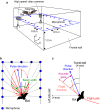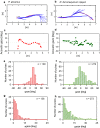Species-specific control of acoustic gaze by echolocating bats, Rhinolophus ferrumequinum nippon and Pipistrellus abramus, during flight
- PMID: 27566319
- PMCID: PMC5061877
- DOI: 10.1007/s00359-016-1121-0
Species-specific control of acoustic gaze by echolocating bats, Rhinolophus ferrumequinum nippon and Pipistrellus abramus, during flight
Abstract
Based on the characteristics of the ultrasounds they produce, echolocating bats can be categorized into two main types: broadband FM (frequency modulated) and narrowband CF (constant frequency) echolocators. In this study, we recorded the echolocation behavior of a broadband FM (Pipistrellus abramus) and a narrowband CF echolocator species (Rhinolophus ferrumequinum nippon) while they explored an unfamiliar space in a laboratory chamber. During flight, P. abramus smoothly shifted its acoustic gaze in relation to its flight direction, whereas R. ferrumequinum nippon frequently shifted its acoustic gaze from side to side. The distribution of the acoustic gazes of R. ferrumequinum nippon was twice as wide as that of P. abramus. Furthermore, R. ferrumequinum nippon produced double pulses twice as often as P. abramus. Because R. ferrumequinum nippon has a horizontal beam width (-6 dB off-axis angle) half as wide (±20.8 ± 6.0°) as that of P. abramus (±38.3 ± 6.0°), it appears to double the width of its acoustical field of view by shifting its acoustic gaze further off-axis and emitting direction-shifted double pulses. These results suggest that broadband FM and narrowband CF bats actively control their acoustic gazes in a species-specific manner based on the acoustic features of their echolocation signals.
Keywords: Acoustical field of view; Beam width; Microphone array; Pulse direction; Telemetry microphone.
Figures





Similar articles
-
Adaptive beam-width control of echolocation sounds by CF-FM bats, Rhinolophus ferrumequinum nippon, during prey-capture flight.J Exp Biol. 2013 Apr 1;216(Pt 7):1210-8. doi: 10.1242/jeb.081398. J Exp Biol. 2013. PMID: 23487269
-
Coordinated Control of Acoustical Field of View and Flight in Three-Dimensional Space for Consecutive Capture by Echolocating Bats during Natural Foraging.PLoS One. 2017 Jan 13;12(1):e0169995. doi: 10.1371/journal.pone.0169995. eCollection 2017. PLoS One. 2017. PMID: 28085936 Free PMC article.
-
Echo-intensity compensation in echolocating bats (Pipistrellus abramus) during flight measured by a telemetry microphone.J Acoust Soc Am. 2007 Mar;121(3):1749-57. doi: 10.1121/1.2431337. J Acoust Soc Am. 2007. PMID: 17407911
-
Adaptive changes in echolocation sounds by Pipistrellus abramus in response to artificial jamming sounds.J Exp Biol. 2014 Aug 15;217(Pt 16):2885-91. doi: 10.1242/jeb.101139. J Exp Biol. 2014. PMID: 25122918
-
Evolution of high duty cycle echolocation in bats.J Exp Biol. 2012 Sep 1;215(Pt 17):2935-44. doi: 10.1242/jeb.073171. J Exp Biol. 2012. PMID: 22875762 Review.
Cited by
-
STEFTR: A Hybrid Versatile Method for State Estimation and Feature Extraction From the Trajectory of Animal Behavior.Front Neurosci. 2019 Jun 28;13:626. doi: 10.3389/fnins.2019.00626. eCollection 2019. Front Neurosci. 2019. PMID: 31316332 Free PMC article.
-
Organization of projection from brainstem auditory nuclei to the inferior colliculus of Japanese house bat (Pipistrellus abramus).Brain Behav. 2018 Aug;8(8):e01059. doi: 10.1002/brb3.1059. Epub 2018 Jul 12. Brain Behav. 2018. PMID: 29999234 Free PMC article.
References
-
- Fenton MB. Convergences in the diversification of bats. Curr Zool. 2010;56:454–468.
-
- Fenton MB. Questions, ideas and tools: lessons from bat echolocation. Anim Behav. 2013;85:869–879. doi: 10.1016/j.anbehav.2013.02.024. - DOI
MeSH terms
LinkOut - more resources
Full Text Sources
Other Literature Sources
Miscellaneous

